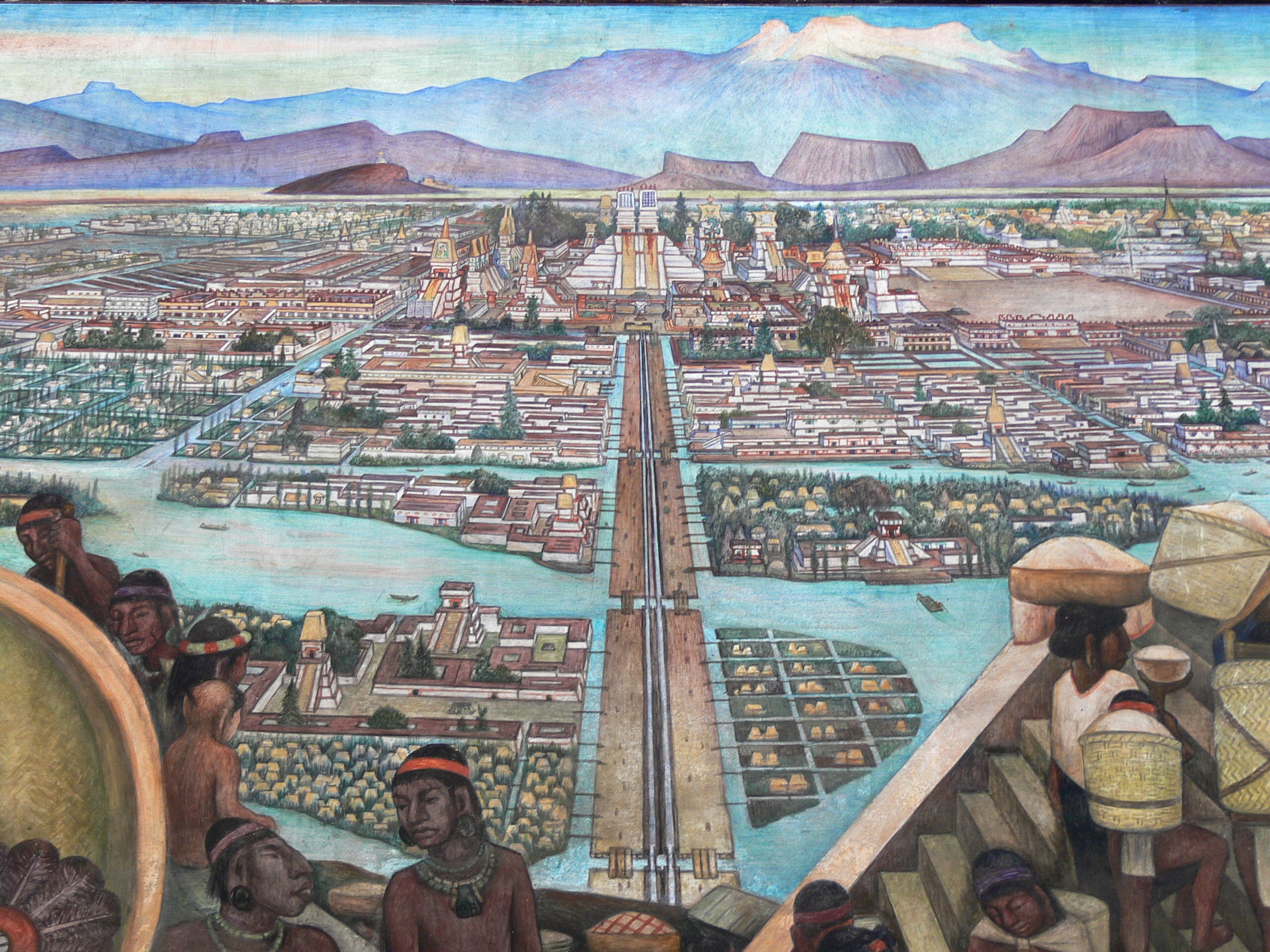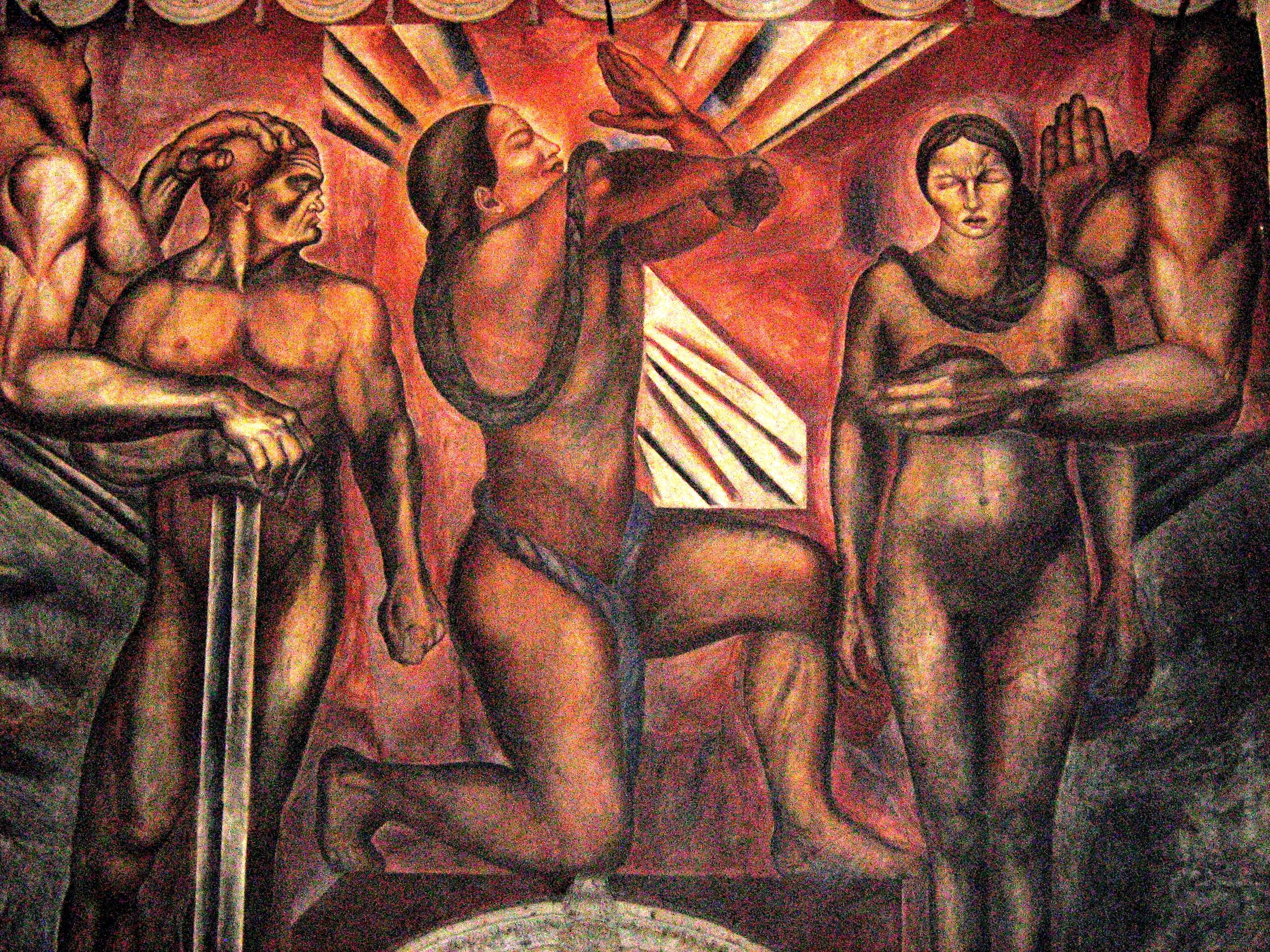|
Débora Arango
Débora Arango Pérez (November 11, 1907 – December 4, 2005) was a Colombian artist, born in Medellín, Colombia as the daughter of Castor María Arango Díaz and Elvira Pérez. Though she was primarily a painter, Arango also worked in other media, such as ceramics and graphic art. Throughout her career, Arango used her artwork to explore many politically charged and controversial issues, her subjects ranging from nude women to the role of the Roman Catholic Church to dictatorships. Personal life First years (1907-1930) Arango was born on November 11, 1907, in the city of Medellín, Antioquia, daughter of the couple formed by the merchant María Arango Díaz and Elvira Pérez. She was the seventh of 11 siblings in a high class family. From an early age she contracted malaria, because of that, she spent several seasons with family members who lived in the suburbs during her childhood. Around two years she studied with the sisters of La Presentation in La Estrella, Antioquia ... [...More Info...] [...Related Items...] OR: [Wikipedia] [Google] [Baidu] [Amazon] |
Medellín
Medellín ( ; or ), officially the Special District of Science, Technology and Innovation of Medellín (), is the List of cities in Colombia, second-largest city in Colombia after Bogotá, and the capital of the department of Antioquia Department, Antioquia. It is located in the Aburrá Valley, a central region of the Andes Mountains, in northwestern South America. The city's population was 2,427,129 at the 2018 Colombian census, 2018 census. The Metropolitan Area of Medellín, metro area of Medellín is the second-largest urban agglomeration in Colombia in terms of population and economy, with more than 4 million people. In 1616, the Spaniard Francisco de Herrera Campuzano erected a small indigenous village (''poblado'') known as "Lawrence of Rome, Saint Lawrence of Aburrá" (''San Lorenzo de Aburrá''), located in the present-day El Poblado (Medellín), El Poblado commune. On 2 November 1675, the queen consort Mariana of Austria founded the "Town of Virgin of Candelaria, Our L ... [...More Info...] [...Related Items...] OR: [Wikipedia] [Google] [Baidu] [Amazon] |
Mexico City
Mexico City is the capital city, capital and List of cities in Mexico, largest city of Mexico, as well as the List of North American cities by population, most populous city in North America. It is one of the most important cultural and financial centers in the world, and is classified as an Globalization and World Cities Research Network, Alpha world city according to the Globalization and World Cities Research Network (GaWC) 2024 ranking. Mexico City is located in the Valley of Mexico within the high Mexican central plateau, at an altitude of . The city has 16 Boroughs of Mexico City, boroughs or , which are in turn divided into List of neighborhoods in Mexico City, neighborhoods or . The 2020 population for the city proper was 9,209,944, with a land area of . According to the most recent definition agreed upon by the federal and state governments, the population of Greater Mexico City is 21,804,515, which makes it the list of largest cities#List, sixth-largest metropolitan ... [...More Info...] [...Related Items...] OR: [Wikipedia] [Google] [Baidu] [Amazon] |
Medellín Museum Of Modern Art
The Museum of Modern Art of Medellín (MAMM, Museo de Arte Moderno de Medellín) is a museum of modern art in the Colombian city of Medellín. It was founded in 1978. Many artworks by Débora Arango, who was born in Medellín, are part of the museum's collection. Leiko Ikemura had a show at the museum in 1999. See also * Bogotá Museum of Modern Art The Bogotá Museum of Modern Art (''Museo de Arte Moderno de Bogotá'', known as MAMBO) is a museum of modern art located in Bogotá, Colombia. It is one of the main cultural and artistic establishments in Colombia. History The museum opened to ... References External links * {{DEFAULTSORT:Medellin Museum of Modern Art Museums in Medellín Art museums and galleries in Colombia Modern art museums ... [...More Info...] [...Related Items...] OR: [Wikipedia] [Google] [Baidu] [Amazon] |
Guerilla Warfare
Guerrilla warfare is a form of unconventional warfare in which small groups of irregular military, such as rebels, partisans, paramilitary personnel or armed civilians, which may include recruited children, use ambushes, sabotage, terrorism, raids, petty warfare or hit-and-run tactics in a rebellion, in a violent conflict, in a war or in a civil war to fight against regular military, police or rival insurgent forces. Although the term "guerrilla warfare" was coined in the context of the Peninsular War in the 19th century, the tactical methods of guerrilla warfare have long been in use. In the 6th century BC, Sun Tzu proposed the use of guerrilla-style tactics in ''The Art of War''. The 3rd century BC Roman general Quintus Fabius Maximus Verrucosus is also credited with inventing many of the tactics of guerrilla warfare through what is today called the Fabian strategy, and in China Peng Yue is also often regarded as the inventor of guerrilla warfare. Guerrilla warfar ... [...More Info...] [...Related Items...] OR: [Wikipedia] [Google] [Baidu] [Amazon] |
La Violencia
''La Violencia'' (, The Violence) was a ten-year civil war in Colombia from 1948 to 1958, between the Colombian Conservative Party and the Colombian Liberal Party, mainly fought in the countryside. ''La Violencia'' is considered to have begun with the assassination on 9 April 1948 of Jorge Eliécer Gaitán, a Liberal Party presidential candidate and frontrunner for the 1949 November election. His murder provoked the '' Bogotazo'' rioting, which lasted ten hours and resulted in around 5,000 casualties. An alternative historiography proposes the Conservative Party's return to power following the election of 1946 to be the cause. Rural town police and political leaders encouraged Conservative-supporting peasants to seize the agricultural lands of Liberal-supporting peasants, which provoked peasant-to-peasant violence throughout Colombia. ''La Violencia'' is estimated to have killed at least 200,000 people, almost 1 in 50 Colombians. Development The ''La Violencia'' conflic ... [...More Info...] [...Related Items...] OR: [Wikipedia] [Google] [Baidu] [Amazon] |
Mexican Muralists
Mexican muralism refers to the art project initially funded by the Mexican government in the immediate wake of the Mexican Revolution (1910–1920) to depict visions of Mexico's past, present, and future, transforming the walls of many public buildings into didactic scenes designed to reshape Mexicans' understanding of the nation's history. The murals, large artworks painted onto the walls themselves had social, political, and historical messages. Beginning in the 1920s, the muralist project was headed by a group of artists known as "The Big Three" or "The Three Greats". This group was composed of Diego Rivera, José Clemente Orozco and David Alfaro Siqueiros. Although not as prominent as the Big Three, women also created murals in Mexico. From the 1920s to the 1970s, murals with nationalistic, social and political messages were created in many public settings such as chapels, schools, government buildings, and much more. The popularity of the Mexican muralist project started a trad ... [...More Info...] [...Related Items...] OR: [Wikipedia] [Google] [Baidu] [Amazon] |
Catholic Church
The Catholic Church (), also known as the Roman Catholic Church, is the List of Christian denominations by number of members, largest Christian church, with 1.27 to 1.41 billion baptized Catholics Catholic Church by country, worldwide as of 2025. It is among the world's oldest and largest international institutions and has played a prominent role in the history and development of Western civilization.Gerald O'Collins, O'Collins, p. v (preface). The church consists of 24 Catholic particular churches and liturgical rites#Churches, ''sui iuris'' (autonomous) churches, including the Latin Church and 23 Eastern Catholic Churches, which comprise almost 3,500 dioceses and Eparchy, eparchies List of Catholic dioceses (structured view), around the world, each overseen by one or more Bishops in the Catholic Church, bishops. The pope, who is the bishop of Rome, is the Papal supremacy, chief pastor of the church. The core beliefs of Catholicism are found in the Nicene Creed. The ... [...More Info...] [...Related Items...] OR: [Wikipedia] [Google] [Baidu] [Amazon] |
Cubism
Cubism is an early-20th-century avant-garde art movement which began in Paris. It revolutionized painting and the visual arts, and sparked artistic innovations in music, ballet, literature, and architecture. Cubist subjects are analyzed, broken up, and reassembled in an abstract form. Instead of depicting objects from a single perspective, the artist depicts the subject from multiple perspectives to represent the subject in a greater context. Cubism has been considered the most influential art movement of the 20th century. The term ''cubism'' is broadly associated with a variety of artworks produced in Paris (Montmartre and Montparnasse) or near Paris (Puteaux) during the 1910s and throughout the 1920s. The movement was pioneered in partnership by Pablo Picasso and Georges Braque, and joined by Jean Metzinger, Albert Gleizes, Robert Delaunay, Henri Le Fauconnier, Juan Gris, and Fernand Léger. One primary influence that led to Cubism was the representation of three-dimensional ... [...More Info...] [...Related Items...] OR: [Wikipedia] [Google] [Baidu] [Amazon] |
Expressionism
Expressionism is a modernist movement, initially in poetry and painting, originating in Northern Europe around the beginning of the 20th century. Its typical trait is to present the world solely from a subjective perspective, distorting it radically for emotional effect in order to evoke moods or ideas. Expressionist artists have sought to express the meaningVictorino Tejera, 1966, pages 85,140, Art and Human Intelligence, Vision Press Limited, London of emotional experience rather than physical reality. Expressionism developed as an avant-garde style before the First World War. It remained popular during the Weimar Republic,Bruce Thompson, University of California, Santa Cruzlecture on Weimar culture/Kafka'a Prague particularly in Berlin. The style extended to a wide range of the arts, including expressionist architecture, painting, literature, theatre, dance, film and music. Paris became a gathering place for a group of Expressionist artists, many of Jewish origin, dubbed th ... [...More Info...] [...Related Items...] OR: [Wikipedia] [Google] [Baidu] [Amazon] |
Colombian Government
The Government of Colombia is a republic with separation of powers into executive, judicial and legislative branches. Its legislature has a congress, its judiciary has a supreme court, and its executive branch has a president. The citizens of Colombia cast votes concerning their government, and they employ a ''public'' sector office for an inspector general to oversee the public interface of the government. This safeguards the public, and guarantees the human rights spelled out in the ''Constitution of 1991'', which provides the framework for a welfare state and a unitary republic. Colombia has "control institutions" that mix government and public officials, who work alongside one another. For example, the public's inspector general works closely with the government's controller general, whose job it is to ensure governmental fiscal responsibility. An independent Ombudsman deals with maladministration complaints and functions. Executive The executive branch of ... [...More Info...] [...Related Items...] OR: [Wikipedia] [Google] [Baidu] [Amazon] |
José Clemente Orozco
José Clemente Orozco (November 23, 1883 – September 7, 1949) was a Mexican caricaturist and painter, who specialized in political murals that established the Mexican Mural Renaissance together with murals by Diego Rivera, David Alfaro Siqueiros, and others. Orozco was the most complex of the Mexican muralists, fond of the theme of human suffering, but less realistic and more fascinated by machines than Rivera. Mostly influenced by Symbolism, he was also a genre painter and lithographer. Between 1922 and 1948, Orozco painted murals in Mexico City, Orizaba, Claremont, California, New York City, Hanover, New Hampshire, Guadalajara, Jalisco, and Jiquilpan, Michoacán. Life José Clemente Orozco was born in 1883 in Zapotlán el Grande (now Ciudad Guzmán), Jalisco to Rosa de Flores Orozco. He was the oldest of his siblings. In 1890 Orozco became interested in art after moving to Mexico City. He married Margarita Valladares, and had three children. At the age of 21, Orozco ... [...More Info...] [...Related Items...] OR: [Wikipedia] [Google] [Baidu] [Amazon] |







